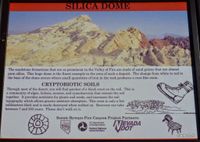Cryprogamic Soil Crust
What is it?
Cryptogamic soil is a very thin layer of life consisting of a variety composition of living organisms including lichens, bryophytes, algae, fungi, and mosses. Algae are the most common and abundant of them all due to their adaptive ability, how ever we more closely associate lichens and moss's due to the fact that we can see them much more clearly with out the assistance of a microscope. These organism can play a huge part in stabilizing the top layer of soil (Horizon O). This is hugely beneficial in making sure that erosive forces like wind and water don't crumble away this important layer and leave the bedrock barren. Cryptogamic crust also can help maintain moisture levels and distribute it deeper into the soil layers along with other important processes such as nitrogen fixation. Depending on where the soil crust is located and which scholar you ask, soil crust can either help or not help vascular plants from establishing and flourishing.
The fact that its only a thin layer on the surface, does mean its fragile and easily acceptable to being killed. This can be done by some animal walking over it in a pasture. Humans hiking up in the mountains has also had a detrimental impact on the population of Soil Crust communities.
Habitat
These types of communities tend to inhabit areas that are arid and semi arid, such as the south western united states. One example of are
Lichens
Lichens are a composite organism, the consist of many different types on individuals working together for a common goal, survival. Lichen arise from cyanobacteria and/or algae which are all ready living among a fungus in a symbiotic lifestyle. Thus creating a new organism that looks and behaves very different then its "parent" organisms. They can vary in habitat they live in, parent organisms and the colors upon which they can display have a huge range.
Lichens are one of the firs living things to start colonizing on barren rock after an event that stripped it of its soil. It starts the process of forming new soil. It does this by releasing acids that break down the rock as it grows over time. This releases rock material and when the lichen dies it is turned into a small layer of soil for the next stage of restoration to occur in.
Growth Styles of Lichens Crustose Foliose Fruticose Squamulose
Algae
Impact
References
Anderson, David C., et al. “Factors Influencing Development of Cryptogamic Soil Crusts in Utah Deserts.” Journal of Range Management, vol. 35, no. 2, 1982, p. 180., doi:10.2307/3898386.
Lesica, et al. “The Effects of Cryptogamic Soil Crust on the Population Dynamics of Arabis Fecunda (Brassicaceae) /.” Details - The Effects of Cryptogamic Soil Crust on the Population Dynamics of Arabis Fecunda (Brassicaceae) /, Helena, Mt. :Montana Natural Heritage Program,[1991], 1 Jan. 1991, www.biodiversitylibrary.org/bibliography/35812.
